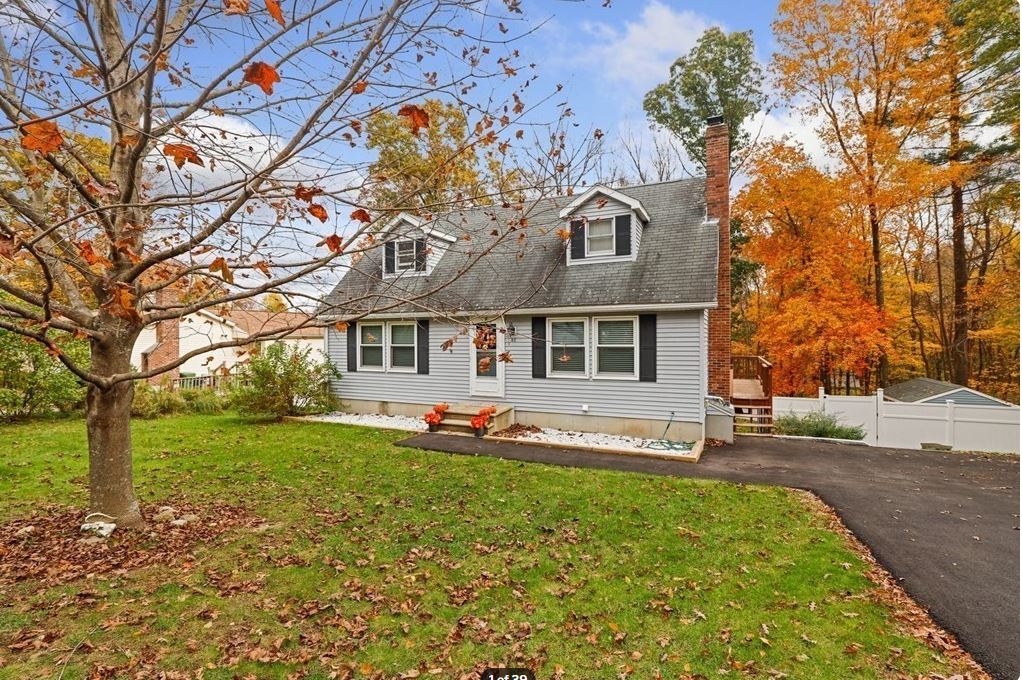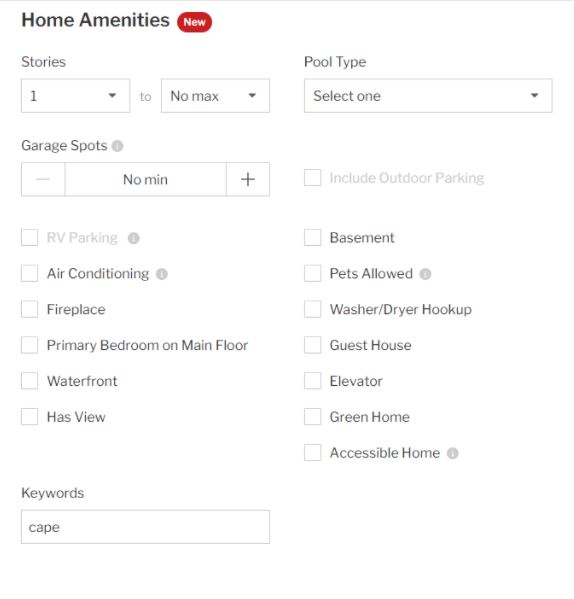When kids are asked to draw a picture of a house in elementary school, they invariably respond with a rectangular shape that features a door in the center, with a window on each side. This simple – but timeless and charming – architectural depiction is a quintessential “Cape Cod” home.
The Cape Cod-style home is architecturally iconic and one of the most popular house styles in the U.S., along with the colonial-style, Tudor-style, and the row house. Learn more about the long history of this quaint architectural style, the defining characteristics that set it apart, and the different types of Cape Cod-style homes.

History of the Cape Cod house style
Cape Cod architecture was named for the Massachusetts coastal region where Puritan carpenters settled at Cape Cod Bay in the 1700s. These craftsmen built simple, one-story homes designed to withstand the harsh, windy climate, using easy-to-find building materials like oak, pine, and cedar. The original rectangular footprint had low ceilings and a large central fireplace and chimney to provide warmth for the whole structure over the long, cold winters. Closely related to the Colonial-style home, the Cape Cod house was designed to be as practical and functional as possible.
Many Cape Cod-style homes are from the pre-Civil war era. The style fell out of popularity temporarily but had a resurgence post World War ll, known as the Cape Cod Revival. These homes were built to help house families and veterans returning from war.
Where can you typically find Cape Cod style houses?
As Americans migrated from east to west, the Cape Cod design and construction moved with them. This is why Cape Cod houses are more often found in colder, snowier climates throughout New England in cities like Manchester, NH, Boston, MA, Cranston, RI, and Stamford, CT. In other areas of the United States, the Cape Cod-style is often mixed with craftsman elements, ranch, or Tudor design.
Defining characteristics of the Cape Cod house
Exterior characteristics and features of the Cape Cod house style
Best known for its characteristic symmetrical design, the Cape Cod has a steep roof featuring pitched triangular areas toward the front and back and a large central chimney. Though traditionally built as a single-story house, today’s Cape Cod-style homes can have multiple floors and additional wings. This home style also features a center-placed front door and shuttered windows on either side. The exterior of the Cape Cod house is commonly clad in cedar shingles but newer homes are also built of brick, stucco, and stone. Window boxes and shutters serve as the primary sources of ornamentation, and black is often used as a popular accent color for doors, shutters, and trims in modern Cape Cod homes.

Interior characteristics and features of the Cape Cod house style
The interior of traditional Cape Cod houses are constructed from durable materials like cedar, oak, and pine. Original Cape Cod homes also had hardwood floors, which remain popular today.
The interior color palette of a traditional Cape Cod home mirrors the exterior environment, often using pastel colors to mimic the sky, grass, water, and sun to add warmth and charm to the interior. Modern Cape Cod interior design opts for a white color palette to add light to the home and create a larger feel in the space.
Modern Cape Cod homes also feature beadboard or board-and-batten elements, along with functional built-ins to add storage. Because many Cape Cods are only 1,200-1,800 square feet, it’s essential to make good use of every square inch. These homes often include built-in bookshelves, china cabinets, beds, reading nooks, and decorative shelves, with beadboard paneling commonly found on kitchen cabinets and ceilings. However, some modern Cape Cod homes no longer include the traditional cabinetry and have smooth-slab doors for a sleek and contemporary look.

Cape Cod-style floor plans and layouts
A traditional Cape Cod layout includes one main living space with the common room also used as the family or living room. A typical home has two to three bedrooms and a big central fireplace to gather around with family, friends, and guests. The upper half-story can be used as bonus space, storage space, or an extra bedroom.
The windows on a Cape Cod play a critical role in creating the charm and curb appeal of this home style. Originally, Cape Cod homes were often built to maximize available sunlight, with the largest and tallest windows facing south. This positioning helped minimize heating costs while taking advantage of natural light. You’ll typically see double-hung windows with shutters on the main floor, and dormers on the second to increase light and air circulation.
Today’s Cape Cod homes offer a range of style upgrades. Many have open floor plans with additional stories, dormers, and wings. In keeping with a more traditional style, you can find floor plans with the front entry or foyer that opens onto a stairway, with a bedroom, study, or office on the right side and a formal living room on the left.
While the traditional layout had rooms separated by walls and doorways to create a closed floor plan, the flow in a modern Cape can be similar to the traditional layout, where all rooms flow toward the kitchen.
A Cape Cod-style house with an open-floor plan eliminates most non-structural walls to create an open and airy flow through the kitchen, dining area, and living room. If the homeowner chooses to add a wing or two and still retain the Cape Cod structure, they can extend a single-story off one or both sides of the home. Occasionally, such extensions may not be possible on a narrow lot, and the home can only be built up to add more living space.
“Homebuyers appreciate the look and style of the classic New England style “Cape Cod” that offers an inviting center staircase to the upper level,” says Richard Thomas, a Market Manager in Connecticut. “While simple in design, the Cape offers multi-level living that often has dormers on the front or rear of the home to expand headroom. The Cape in its design is a more affordable option to the colonial-style for buyers since the second level is built into the high pitched roof, yet offers many of the same features that homebuyers love.”
Different types of Cape Cod-style architecture
Not all Cape Cod homes feature its characteristic symmetry. Let’s dive into the three different expressions of Cape Cod-style in architectural design:
Half-Cape Cod house style
The half-Cape has a single, off-center door with two windows to one side. The layout usually centers around a large central fireplace and the common room or kitchen, with the bedrooms, pantries, parlor, and rear entry branched off the central kitchen.

Three-quarter Cape Cod house style
The three-quarter Cape is slightly wider than the half-Cape with one window added on the other side of the door for balance. This style was traditionally considered as the “starter home.”

Full-Cape Cod house style
The full Cape is the most accurate representation of the original architecture. The home is symmetrical, with a centered door, windows on each side, and a large central chimney.

Pros and cons of Cape Cod-style architecture
Pros of Cape Cod-style architecture
The smaller size can be a positive attribute for Cape Cod homes, making them affordable, practical, and efficient – yet cozy and charming. There’s less space to clean, heat, maintain, or furnish, and many rooms are multi-functional, with built-in shelving and storage features. The exterior commonly features a smaller yard, which means less mowing and shoveling. The steep roofs also prevent heavy snow from accumulating over the winter. Overall, the Cape Cod-style house is an excellent choice for homebuyers searching for a modestly sized home, whether as a starter home or when it’s time to downsize.
Cons of Cape Cod-style architecture
With modest square footage that typically ranges from 1,200 to 1,800 square feet, the Cape Cod is smaller than most homes built today, which average around 2,300 square feet.
For a Cape Cod with an attic converted to living space, the attic runs the risk of not being well insulated, making the home more susceptible to ice dams, which can cause interior leaking or mold. Traditional Cape Cod homes may also have outdated kitchens, uneven floors, unfinished basements, or attics not suitable for living space.
Design ideas for Cape Cod-style houses
The Cape Cod-style house represents an iconic time in U.S. history. The traditional decor and construction materials give tribute to durability and function. If you’re looking to update your home or give it a complete facelift, here are a few fresh design ideas that can breathe new life into a Cape Cod house.

Simple paint colors
You don’t need a complicated color palette when decorating a Cape Cod – staying simple is the best compliment to this home. Neutrals like white, grey, and black create a blank canvas on the exterior; if you’re looking to stand out, consider a nod to nature with light blues, light yellows, and seafoam greens. To give your exterior new life, add pops of color with decorative shutters.
Embrace the outdoor space
Homeowners can also create a backyard living area without interfering with the Cape Cod home’s quaint, historic charm. You can find patios and decks in many Cape Cod backyards with comfortable furniture for entertaining friends and family. Winters can get cold in New England, so a fire pit would be a nice addition to enjoy the fall and winter seasons.
Consider an addition
The structure of a Cape Cod makes it easy to add to another section of the house or connect to a detached garage without losing the home’s iconic style. In these cases, homeowners have the option to extend the back of the home or add another story for additional space.
Decorative details
Traditionally, a Cape Cod exterior is plain and unadorned. However, you can easily personalize this home style by adding window boxes for flowers, painting your chimney a bold color, putting up a picket fence in color other than white, or adding colored shutters. These small changes can update and modernize your Cape Cod from traditional to contemporary.
How to find Cape Cod-style houses for sale in your area
If a Cape Cod-style house suits your style, Redfin can help you find one in your area. It’s as simple as:
- Go to Redfin.com and type into the Search Bar either the name of the city or a zip code where you’d like to begin looking for a home – Boston, MA for example. Press enter.

- Near the top of the next page, on the right side, you will see, “More Filters.” Click that button and scroll to the “Keywords” box near the bottom of the page.
- Type the word “Cape” into the Keywords box and press “Apply Filters.” Voila! All Cape Cod-style houses within the zip code you entered will populate the page, and you’ll be able to begin your search.

The post Cape Cod House Style: Simplicity Meets Timeless Charm appeared first on Redfin | Real Estate Tips for Home Buying, Selling & More.
